| Published: | 2010-03-03 |
| Manufacturer: | Scratch |
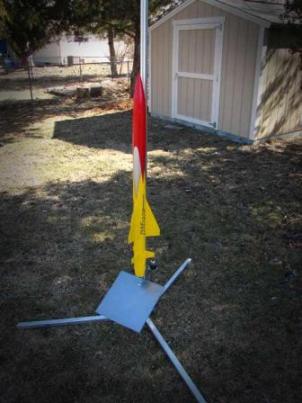 Brief:
Brief:
This is an article on how to convert an aluminum Army cot into a launch pad capable of handling a rail or launch rods. It is meant to be simple enough that no measuring has to be done and the only tools needed is a wrench, drill, and pop rivet gun.
Construction:
The conversion consists of one used aluminum army cot, various nuts, bolts, and washers, a blast shield of your choice, drill chuck, and a 2" angle bracket.
The first thing I did was to disassemble the cot in the center by unbolting the legs. A set of legs include one split leg and one full length leg. I took the full length center leg with the "T" shaped bracket and set it to the side. I then drilled out the rivets holding the other two long legs on the cot and bolted them to the other ends of the "T" bracket on the first leg. This serves as the base of the launch pad.


Next I drilled out the pivoting rivet on one of the split end legs and removed the "S" shaped bracket as well. This is the tower of the launch pad. I then set the split leg I had just removed on the middle leg of the base letting the "L" bracket straddle the leg close to the "T" bracket. I drilled a hole in the center leg that corresponded to the hoe in the L bracket that I had just removed the rivet from. I then bolted it in place.
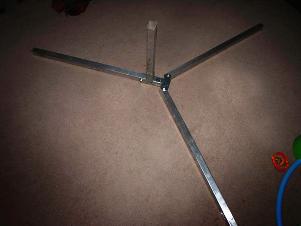
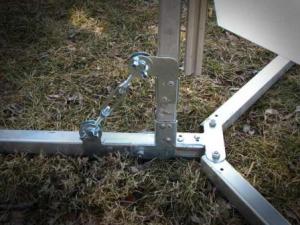
I removed another "L" bracket from another leg not being used and placed one side on the tower and one side on the center leg so as to allow the tower to collapse back onto the leg and the brackets not interfere with each other. I drilled holes for these and riveted them in place. These are the brackets for the turnbuckle. I installed the turnbuckle and proceeded to install the drill chuck.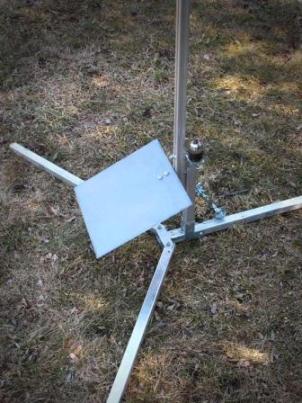
To install the drill chuck I drilled a hole in one side of a 2" angle bracket dead center to accept the bolt for the chuck. I then ran the bolt through, with fender washer in place and screwed the chuck on. I placed the bracket on the top "high" side of the tower next, and drilled and riveted it in place.
For a rail, I used a 5 foot section of 1010 8020 rail. To attach it I used 1/4"-20 machine bolts. I ran the heads of two of these bolts into the channel of the rail and screwed them in place with a washer and nut where they would pass through the two holes already present in the tower section. I used red locktite to secure the bolts permanently. The holes in the tower were then drilled out wider to accept the bolts, and the rail was bolted in place using hex nuts, washers, and split washers.
I added a blast deflector by attaching a 1'X1' sheet of steel with a bent angle bracket in the same fashion I attached the rail to the tower. I also added a rocket rest, or stop to the rail by running a short machine screw down the channel and adding three nuts to it.

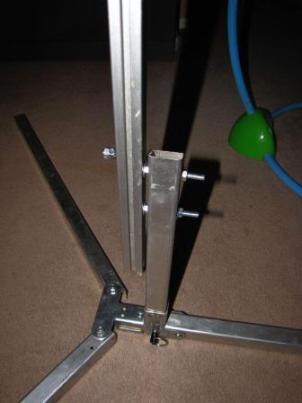
Summary: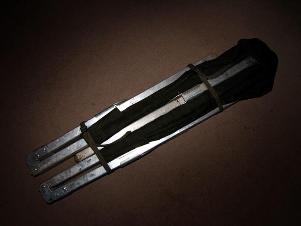 This launch pad is light, compact, and easy to set up. It requires minimal space to store, and will hold a decent sized rocket. the versatility of being able to handle a rail, or any size rod makes it great for club events.
This launch pad is light, compact, and easy to set up. It requires minimal space to store, and will hold a decent sized rocket. the versatility of being able to handle a rail, or any size rod makes it great for club events.
I have not used this launch pad enough yet to notice any real cons.
Other:
Do not try to grind or cut aluminum with a regular grinder. This is dangerous and could cause the grinding wheel to come apart while in use.
Sponsored Ads
 |
 |










![Vintage Estes Viper #0820 Model Rocket [4*G-17.25] Vintage Estes Viper #0820 Model Rocket [4*G-17.25]](https://i.ebayimg.com/thumbs/images/g/Q7EAAOSwN1Nl1kDF/s-l225.jpg)
